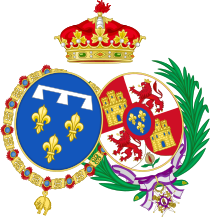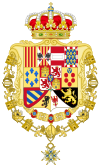Infanta Luisa Fernanda, Duchess of Montpensier
| Infanta Luisa Fernanda | |||||
|---|---|---|---|---|---|
| Duchess of Montpensier | |||||
 Portrait by Federico de Madrazo y Kuntz, 1851 | |||||
| Born | 30 January 1832 Royal Palace of Madrid, Spain | ||||
| Died | 2 February 1897 (aged 65) San Telmo Palace, Seville, Spain | ||||
| Burial | 2 February 1897 Infantes Pantheon, Royal Monastery of San Lorenzo de El Escorial, Spain | ||||
| Spouse | Prince Antoine, Duke of Montpensier
(m. 1846; died 1890) | ||||
| Issue among others... | Infanta Isabel, Countess of Paris Infanta Maria Amelia Infanta María Cristina Infanta Maria de la Regla Infante Fernando Mercedes, Queen of Spain Infante Felipe Infante Antonio, Duke of Galliera Infante Luis | ||||
| |||||
| House | Bourbon | ||||
| Father | Ferdinand VII of Spain | ||||
| Mother | Maria Christina of the Two Sicilies | ||||
| Religion | Roman Catholicism | ||||
| Signature | |||||
| Royal styles of Infanta Luisa Fernanda of Spain, Duchess of Montpensier | |
|---|---|
| Reference style | Her Royal Highness |
| Spoken style | Your Royal Highness |
Infanta María Luisa Fernanda of Spain, Duchess of Montpensier (30 January 1832 – 2 February 1897) was Infanta of Spain and Duchess of Montpensier. She was the youngest daughter of King Ferdinand VII of Spain and his fourth wife Maria Christina of the Two Sicilies, the queen-regent, who was also his niece.
Biography[]
Heiress-presumptive[]

When her elder sister Isabella II of Spain succeeded to the throne, Infanta Luisa Fernanda was heir presumptive to the crown between 1833 and 1851, when Isabella's oldest surviving daughter was born.
Marriage[]
Luisa Fernanda was engaged to the Duke of Montpensier, the youngest son of King Louis Philippe, who also was Luisa's mother's first cousin.
Luisa Fernanda, only 14 years old, and Antoine, 22, had their nuptials on 10 October 1846 as a double wedding with Isabella and Francis', and young Antoine was elevated to the rank of an Infante of Spain. The couple moved to Paris and later to Sevilla. The relationship between Isabella and her sister was tense, due to Antoine's conspiracies against the queen.[1]
Antoine's father was deposed in 1848. The same year, the then 16-year-old Luisa Fernanda gave birth to their first child, Maria Isabel. After Isabella was deposed, the family went into exile. Luisa returned to Sevilla years later, already widowed, where she died.[1] She is buried at Escorial.
Children[]

Luisa Fernanda and Antoine had nine children, but only six of them reached adulthood.[2][unreliable source?]
- Infanta Maria Isabel (1848–1919), who married her first cousin Philippe, comte de Paris (1838–1894), the French claimant, and became known as Madame the comtesse de Paris. She had several children, including Princess Louise of Orléans, the maternal grandmother of King Juan Carlos I.
- Infanta Maria Amelia (1851–1870).
- Infanta Maria Cristina (1852–1879). After her younger sister Mercedes died, she was engaged to Alfonso XII, five years her junior, but she died before the wedding.
- Infanta Maria de la Regla (1856–1861).
- [?] (1857–1857).
- Infante Fernando (1859–1873).
- Infanta Maria de las Mercedes (1860–1878), otherwise Princess Marie des Graces d'Orleans-Montpensier, who married her first cousin Alfonso XII and is historically known as Mercedes of Orléans, Queen of Spain. No children.
- Infante Felipe Raimundo Maria (1862–1864)
- Infante Antonio, Duke of Galliera (1866–1930), became Duke of Galliera in Italy. He married his first cousin Infanta Eulalia of Spain (1864–1958), daughter of Isabella II, and had two sons: Infante Alfonso and Infante Luís.
- Infante Luis Maria Felipe Antonio (1867–1874)
Descendants[]

Of all her children, just Isabelle de Paris and Antonio di Galliera left children. Through Antonio, the now non-royal line of dukes di Galliera continues. Alfonso's grandchildren lost royal status due to non-dynastic marriages. The current Duke di Galliera is Alfonso's great-grandson, Don Alfonso Francesco de Orléans-Borbón y Ferarra-Pignatelli.[2]
Through Marie Isabelle, she became great-grandmother of king Manuel II of Portugal, Amedeo, Duke of Aosta, Aimone, Duke of Spoleto and Luis Filipe, Duke of Braganza; great-great-grandmother of Juan Carlos I of Spain and Henri, Count of Paris.
Arms[]
- Heraldry of Infanta Luisa Fernanda of Spain, Duchess of Montpensier

Coat of arms of Infanta Luisa Fernanda

Arms of alliance of Infanta Luisa Fernanda and her husband

Arms as Duchess Dowager
Ancestry[]
| showAncestors of Infanta Luisa Fernanda, Duchess of Montpensier |
|---|
References[]
- ^ Jump up to: a b [1] Archived November 2, 2005, at the Wayback Machine
- ^ Jump up to: a b "HRH Infanta Doña Luisa Fernanda and her descendants". Archived from the original on October 28, 2009. Retrieved 2006-07-06.CS1 maint: bot: original URL status unknown (link)
- ^ Jump up to: a b Chisholm, Hugh, ed. (1911). . Encyclopædia Britannica. 10 (11th ed.). Cambridge University Press.
- ^ Jump up to: a b Ortúzar Castañer, Trinidad. "María Cristina de Borbón dos Sicilias". Diccionario biográfico España (in Spanish). Real Academia de la Historia.
- ^ Jump up to: a b Genealogie ascendante jusqu'au quatrieme degre inclusivement de tous les Rois et Princes de maisons souveraines de l'Europe actuellement vivans [Genealogy up to the fourth degree inclusive of all the Kings and Princes of sovereign houses of Europe currently living] (in French). Bourdeaux: Frederic Guillaume Birnstiel. 1768. p. 9.
- ^ Jump up to: a b Genealogie ascendante jusqu'au quatrieme degre inclusivement de tous les Rois et Princes de maisons souveraines de l'Europe actuellement vivans [Genealogy up to the fourth degree inclusive of all the Kings and Princes of sovereign houses of Europe currently living] (in French). Bourdeaux: Frederic Guillaume Birnstiel. 1768. p. 96.
- ^ Jump up to: a b Chisholm, Hugh, ed. (1911). . Encyclopædia Britannica. 10 (11th ed.). Cambridge University Press.
- ^ Jump up to: a b Navarrete Martínez, Esperanza. "María de la O Isabel de Borbón". Diccionario biográfico España (in Spanish). Real Academia de la Historia.
- Spanish infantas
- House of Bourbon (Spain)
- 1832 births
- 1897 deaths
- Princesses of France (Orléans)
- House of Orléans
- Burials in the Pantheon of Infantes at El Escorial
- Duchesses of Montpensier
- French princesses
- French duchesses
- 19th-century French people
- 19th-century Spanish people





